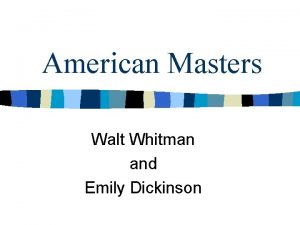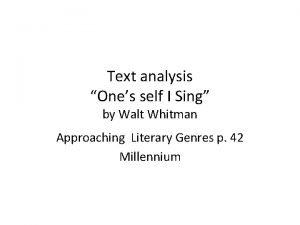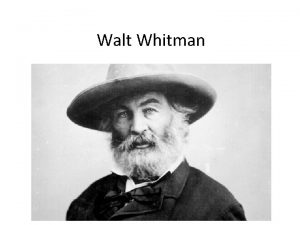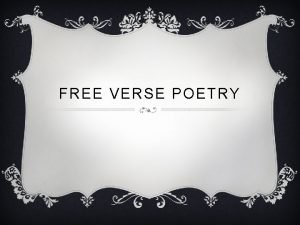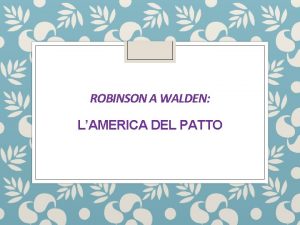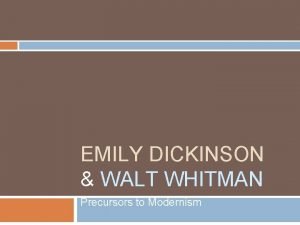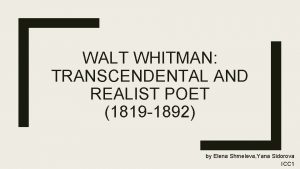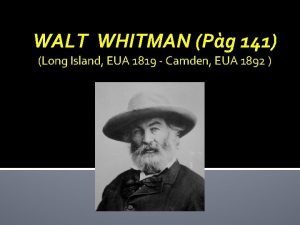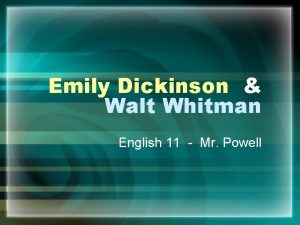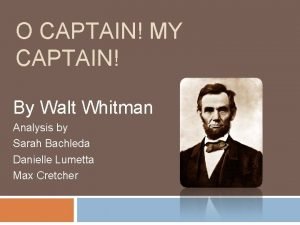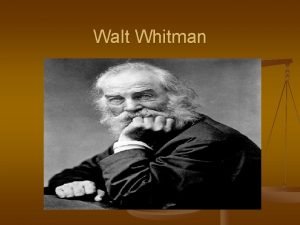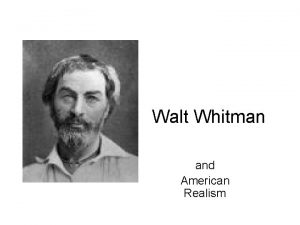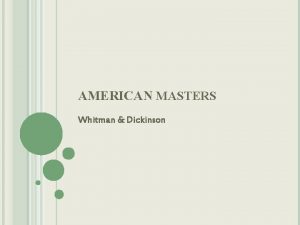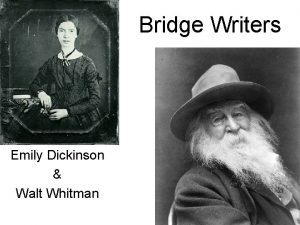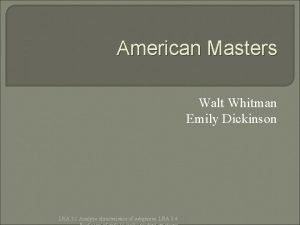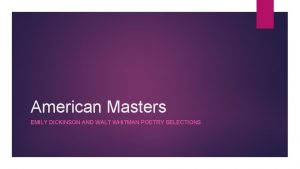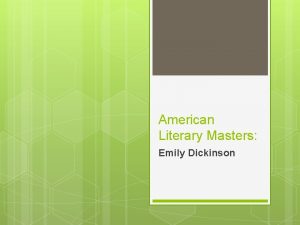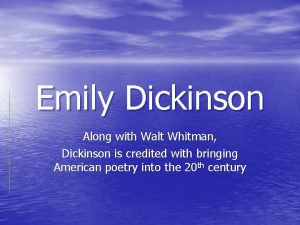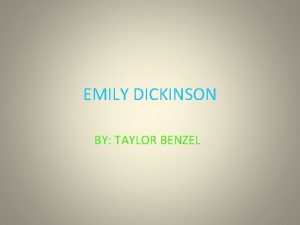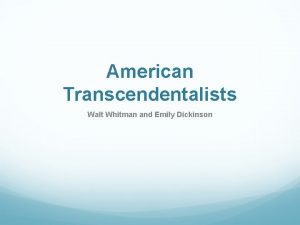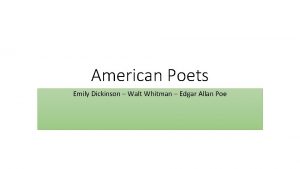AMERICAN MASTERS Whitman Dickinson WALT WHITMAN EMILY DICKINSON












- Slides: 12

AMERICAN MASTERS Whitman & Dickinson

WALT WHITMAN & EMILY DICKINSON Known as the two greatest poets of the 19 th century Both poets were close observers of people and life’s daily activities However…complete opposites in character and personality

TWO OPPOSITE INDIVIDUALS Whitman Dickinson Sociable and loved company Was a traveler Public spokesman and an advocate of progress Expected his poetry would be well read and useful Private and shy Happy staying in one isolated spot throughout her life Homebody – found metaphors for the spirit in nature Didn’t expect popularity through her poetry

EMILY DICKINSON – BACKGROUND 1830 – 1886 (56 yrs) At 24, her father (U. S. Congressman) took her with him to D. C. and Philadelphia. This journey seems to mark a turning point in her life. While in Philadelphia, she fell in love with Charles Wadsworth (a married pastor). He inspired her… Wadsworth ended up taking a new assignment in San Francisco – caused a crisis for Dickinson quietly withdrew from all social life except with her immediate family. Wore all white clothing - Went into a state of seclusion Her only activities: writing poems, housework Mostly kept her poetry to herself (lacked concern for an audience) – told her family to destroy her poems left behind after her death (although bundled and hid them before death) Poems that were discovered were eventually published (after some changes)

Example of how her poetry had been changed… Dickinson’s Poem on Fame is a bee. It has a song – We passed School, where Children strove At Recess – in the Ring – We passed the Fields of Grazing Grain We passed the Setting Sun What it was changed to by an editor: We passed the school where children played Their lessons scarcely done; We passed the fields of grazing grain, We passed the setting sun. It has a sting – Ah, too, it was a wing. What do “song, ” “sting, ” and “wing” represent?

WALT WHITMAN – BACKGROUND 1819 - 1892 (73 yrs) Lived in Long Island Never became a scholar – never went to college Worked as an office clerk, printers assistant and teacher Eventually gained an interest in journalism and became an editor Supplemented his income by working as a carpenter and building contractor During this time, he quietly kept notebooks and put together a collection of poetry 1855 – published Leaves of Grass

Leaves of Grass Collection of 12 poems: a spiritual autobiography Tells the story of an enchanted observer who says who he is at every opportunity and claims what he loves by naming it Was too bold and strange to get notice Sent copies to reviewers and other readers, including Ralph Waldo Emerson responded with a positive and supportive letter Went through many revisions Final edition was published in 1891. Whitman’s poetry changed the traditional way that poetry was written. LEAVES OF GRASS I am the poet of the Body and I am the poet of the Soul. . . I am the poet of the woman the same as the man… I am not the poet of goodness only, I do not decline to be the poet of wickedness also…

WHITMAN’S RATIONALE His rationale for the free verse style that he used… Should be free to express naturally an idea or picture A detailed list of component parts is more effective than a selection of fundamental elements This justifies his long catalogues of nouns, participles, and parallel phrases within his verse. The primary aim of poetry is to teach and inspire Meaning… style should be secondary Simplicity is better than fanciness Rhyme and elaborate figures of speech may become too artificially decorative Subject matter should be as broad as life itself

TWO POETS – DIFFERENT INDIVIDUALS Whitman’s poetry – boldly published during his life Dickinson’s poetry – career began after her death Whitman aimed for the large overall impression Filled his pages with long lists as he struggled to catalog everything in sight His technique: Based on cadence – the long, easy sweep of sound that echoes the Bible and the speeches of orators and preachers Cadence is his basis for free verse – poetry without rhyme or meter Dickinson aimed to evoke the feeling of things rather than simply name them Careful in word choice and phrases Her technique: Stanzas are controlled by rhyme and meters (like she found in her hymn book).

MODELS FOR THE FUTURE Whitman’s cadences of free verse have become a part of current public speech and modern literature Dickinson’s demanding rhyme and meter still attract young writers who regard poetry as experiences rather than statements Ezra Pound (poet) Admired Dickinson’s strictness and disliked the expansiveness of Whitman. Wrote “A Pact” (an agreement) Serves as a blessing that represents the feeling of every poet who has envied the artistry of Dickinson and the power of Whitman.

EZRA POUND – “A PACT” I make a pact with you, Walt Whitman – I have detested you long enough. I come to you as a grown child Who has had a pig-headed father; I am old enough now to make friends. It was you the broke the new wood, Now is a time for carving. We have one sap and one root – Let there be commerce between us.

VOCAB. FOR POETRY UNIT Cadence Free Verse Catalogues Alliteration Assonance Imagery Onomatopoeia Parallel Structure Exact Rhyme Slant Rhyme Personification Irony Paradox
 Similarities between walt whitman and emily dickinson
Similarities between walt whitman and emily dickinson Walt whitman one's self i sing analysis
Walt whitman one's self i sing analysis Emily dickinson and transcendentalism
Emily dickinson and transcendentalism What is freeverse
What is freeverse Andai nei boschi walt whitman testo
Andai nei boschi walt whitman testo Walt whitman modernism
Walt whitman modernism Walt whitman bio
Walt whitman bio Transcendentalism whitman
Transcendentalism whitman Walt whitman house long island
Walt whitman house long island Walt whitman english
Walt whitman english Internal rhyme in o captain my captain
Internal rhyme in o captain my captain Walt whitman biografia
Walt whitman biografia Walt whitman photography
Walt whitman photography
